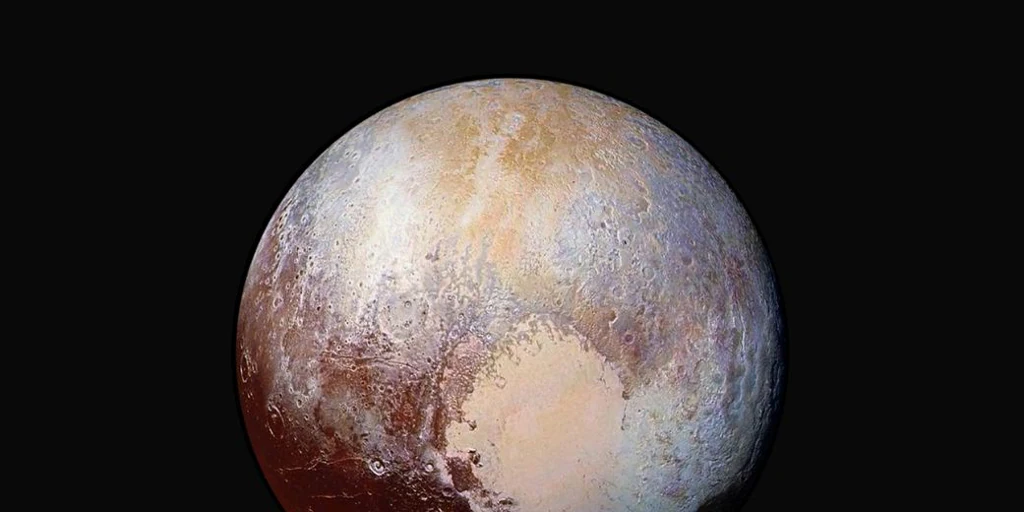This is how Pluto managed to get his “heart”

When NASA’s New Horizons spacecraft flew past Pluto in 2015, the first images it sent back to Earth contained an unexpected surprise: a strange, huge, bright, heart-shaped region standing out starkly against the dwarf planet’s dark surface. Known as the “Tombaugh region” after the astronomer who discovered Pluto in 1930, the area is 1,800 km from east to west and 1,500 km from north to south, and from the moment they saw it, scientists have been trying to figure out why. created and why it is so different from the rest of the planet. And what’s even more intriguing is why the plain that forms the western part of the region, known as Sputnik Planitia, lies about 4 km below the surrounding terrain.
Now a team of researchers from the universities of Bern (Switzerland) and Tucson (Arizona) believe they have found clues to the origins of this huge cosmic heart. The heart, composed mainly of nitrogen ice, was formed by the “slow impact” of a large ice rock with a diameter of about 730 km. The study has just been published in the journal Nature Astronomy.
The researchers came to this conclusion after using computer models to simulate different types of impacts on Pluto’s surface and study the resulting formations. And they confirmed that the light colors of the Tombaugh region are due to the presence of nitrogen ice, very different from that covering the rest of the planet.
“Although most of Pluto’s surface is composed of methane ice and its derivatives on top of a crust of water ice,” says Harry Ballantyne, lead author of the study, “Sputnik Planitia is predominantly filled with nitrogen ice, likely shortly after the impact.” The eastern part of the heart is also covered with a similar, but much thinner layer of nitrogen ice, but its origin is still unclear to scientists, although it is likely also related to Sputnik Planitia.
In the illustration, a large icy body collides with Pluto.
Roger Thibault/University of Bern
Slow Impact
According to Eric Asphaug, a professor at the University of Arizona’s Lunar and Planetary Laboratory and co-author of the paper, collisions between frozen bodies that occur within the solar system are not similar to those that occur near the sun. “We are accustomed,” says the researcher, “to thinking of planetary collisions as incredibly intense events in which we can ignore the details, except for such aspects as energy, momentum and density. But in the distant solar system, speeds are much slower and solid ice is strong, so you’ll have to be much more precise in your calculations. “This is where the fun starts.”
“Pluto’s core is so cold,” says Ballantyne, “that the rocks remained very hard and did not melt despite the heat of the impact. “In addition, due to the impact angle and low speed, the impactor core did not sink below Pluto’s surface, but remained intact, as if it had been struck.”
Led by Martin Jutzi from the University of Bern, the team used a modeling technique called smoothed particle hydrodynamics to test different impact angles and impactor sizes to find out what type of impact could lead to the formation of Sputnik Planitia, a western planet. part of Pluto’s heart, approximately 2,000 square kilometers in area and located about 4 kilometers below its surroundings. It really looks like a colossal dent, formed as a result of a colossal impact on a planetary scale.
Modeling showed that this formation arose very early in Pluto’s history, likely following an oblique impact that resulted in its elongated shape. According to the authors, the ice block that struck Pluto had a diameter of about 730 km, but due to the planet’s icy core, the impact did not melt or liquefy any of its parts, which would have happened closer to the Sun, causing the object to sink below the surface.
Instead, the impactor was crushed by Pluto’s hard floor, and scientists believe that even now it may still be under the thin layer of nitrogen ice covering Sputnik Planitia. According to Asphaug, “somewhere beneath Sputnik lies the remnant core of another massive body that Pluto never completely digested.”
There is no underground ocean
The modeling also suggests there is no subsurface ocean beneath Pluto’s icy shell, as some previous studies have indicated. Because the “heart” has less mass than the rest of the planet’s surface, the entire region must have gradually migrated poleward due to Pluto’s rotation over many millions of years. But instead the formation is located near the equator: an odd position that previous studies had suggested could be due to the dynamics of a huge mass of underground liquid water.
The new study, however, clearly shows that an underground liquid ocean is not needed to explain the location of Pluto’s heart. “In our simulations,” says Jutzi, “Pluto’s entire primordial mantle is destroyed by the impact, and when material from the impactor’s core crashes into Pluto’s core, a localized excess mass is created that could explain the migration toward Pluto. The equator without the need for an underground ocean or, at best, a very shallow one.